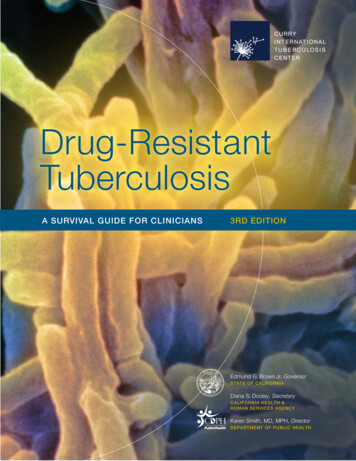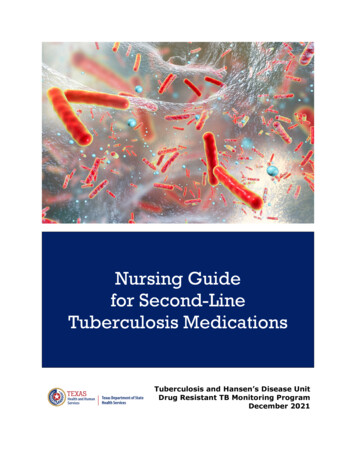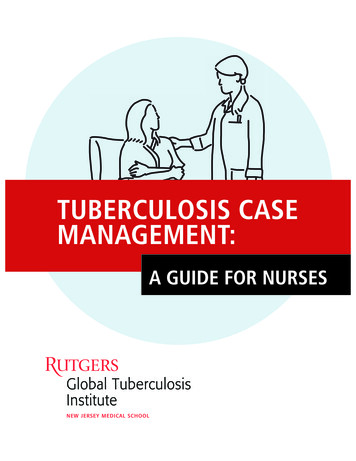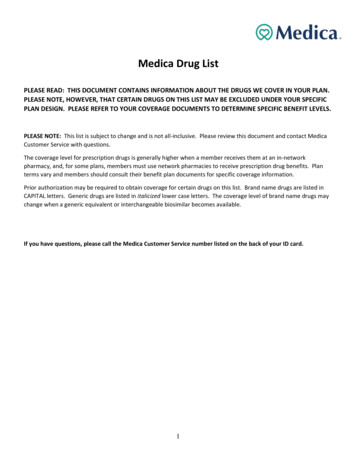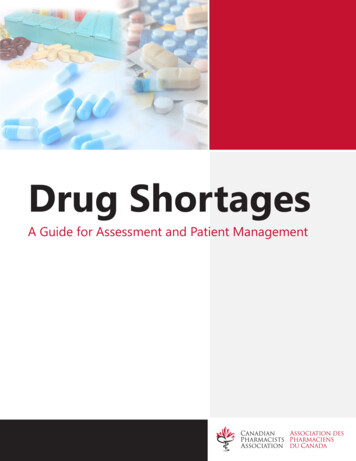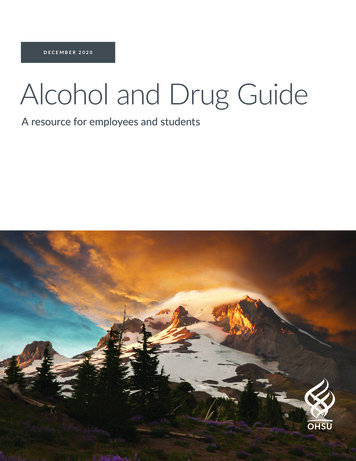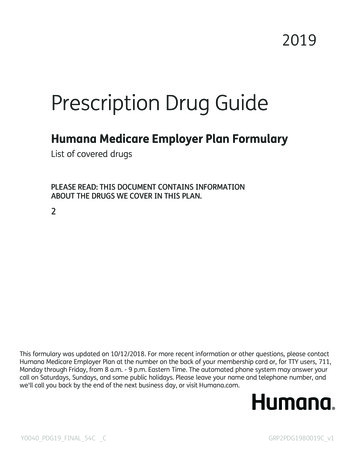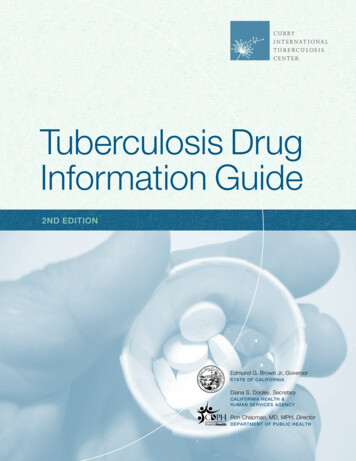
Transcription
Tuberculosis DrugInformation Guide2nd editionEdmund G. Brown Jr, GovernorState of CaliforniaDiana S. Dooley, SecretaryCalifornia Health &Human Services AgencyRon Chapman, MD, MPH, DirectorDepartment of Public Health
Tuberculosis DrugInformation Guide2nd editionEdmund G. Brown Jr, GovernorState of CaliforniaDiana S. Dooley, SecretaryCalifornia Health &Human Services AgencyRon Chapman, MD, MPH, DirectorDepartment of Public HealthDrugInfo 2ndEd v9.indd 312/5/12 3:55 PM
Tuberculosis Drug Information Guide, 2nd edition was created through a collaboration ofthe Curry International Tuberculosis Center (CITC) and the State of California Departmentof Public Health, Tuberculosis Control Branch (CDPH).CITC is a project of the University of California, San Francisco, funded by the Centers forDisease Control and Prevention (CDC). The development of this Guide was fundedthrough CDC Cooperative Agreement U52 CCU 900454.Permission is granted for nonprofit educational use and library duplication and distribution.Suggested citation:Curry International Tuberculosis Center and California Department of Public Health,2012: Tuberculosis Drug Information Guide, 2nd edition.This publication is available on the CITC website: n: Edi Berton DesignDrugInfo 2ndEd v9.indd 412/5/12 3:55 PM
ContributorsAcknowledgmentsAnn M. Loeffler, MDJohn S. Bradley, MDRady Children’s Hospital San Diego, San Diego, CaliforniaPediatric Infectious Diseases Attending and Director of PediatricHospitalists at Randall Children’s Hospital at Legacy Emanuel,Portland, OregonPediatric Tuberculosis Consultant,Curry International Tuberculosis Center,San Francisco, CaliforniaCharles A. Peloquin, PharmD, FCCPProfessor, and Director, Infectious Disease Pharmacokinetics Lab.College of Pharmacy, and Emerging Pathogens InstituteUniversity of Florida,Gainesville, FloridaGisela F. Schecter, MD, MPHConsultant, Multidrug-Resistant Tuberculosis (MDR-TB) ServiceTuberculosis Control Branch,Division of Communicable Disease ControlCenter for Infectious DiseasesCalifornia Department of Public Health,Richmond, CaliforniaEditorsDaniel Deck, Pharm.D.Department of Pharmaceutical Services,San Francisco General Hospital, CaliforniaDavid Forinash, RPhRandall Children’s Hospital at Legacy Emanuel, Portland, OregonFay HuiSan Francisco Department of Public Health,Tuberculosis Control Division, CaliforniaJim HungerSan Francisco Department of Public Health,Tuberculosis Control Division, CaliforniaCaitlin Reed, MD, MPHInpatient Tuberculosis Unit, Infectious Diseases Division,Olive View-UCLA Medical Center, Sylmar, CaliforniaBrian TumminelloBristol Meyer Squibb, New York, New YorkElena Valcarlos, PharmDAnn M. Loeffler, MDGisela F. Schecter, MD, MPHRandall Children’s Hospital at Legacy Emanuel, Portland, OregonCo-editorsPennan Barry, MD, MPHLeslie Henry, BSN, PHNGayle Schack, RN, PHN, MSNeha Shah, MD, MPHLisa True, RN, MSCharles L. Daley, MDProfessor, Department of MedicineChief, Division of Mycobacterial and Respiratory InfectionsNational Jewish Medical and Research Center,Denver, ColoradoJennifer M. Flood, MD, MPHChief, Tuberculosis Control BranchDivision of Communicable Disease ControlCenter for Infectious DiseasesCalifornia Department of Public Health,Richmond, CaliforniaMDR-TB Service, Tuberculosis Control Branch,Division of Communicable Disease Control,Center for Infectious Diseases,California Department of Public Health, Richmond, CaliforniaProject CoordinatorKay Wallis, MPHSpecial Projects ManagerCurry International Tuberculosis Center,San Francisco, Californiacontributors & acknowledgmentsDrugInfo 2ndEd v9.indd 1i12/5/12 3:55 PM
Table of ContentsIntroduction . . . . . . . . . . . . . . . . . . . . . . . . . . . . . . . . . . . . . . . . . . . . . . iiiList of Acronyms and Abbreviations . . . . . . . . . . . . . . . . . . . . . . . . . . ivNew Anti-TB Drugs in the Pipeline . . . . . . . . . . . . . . . . . . . . . . . . . . . . vMedication Fact SheetsAmikacin . . . . . . . . . . . . . . . . . . . . . . . . . . . . . . . . . . . . . . . . . . . . . .1Amoxicillin/clavulanate . . . . . . . . . . . . . . . . . . . . . . . . . . . . . . . . . . .3Capreomycin . . . . . . . . . . . . . . . . . . . . . . . . . . . . . . . . . . . . . . . . . . .5Clarithromycin . . . . . . . . . . . . . . . . . . . . . . . . . . . . . . . . . . . . . . . . . .7Clofazimine . . . . . . . . . . . . . . . . . . . . . . . . . . . . . . . . . . . . . . . . . . . .9Cycloserine . . . . . . . . . . . . . . . . . . . . . . . . . . . . . . . . . . . . . . . . . . .11Ethambutol . . . . . . . . . . . . . . . . . . . . . . . . . . . . . . . . . . . . . . . . . . .13Ethionamide . . . . . . . . . . . . . . . . . . . . . . . . . . . . . . . . . . . . . . . . . . .15Imipenem . . . . . . . . . . . . . . . . . . . . . . . . . . . . . . . . . . . . . . . . . . . . .17Isoniazid . . . . . . . . . . . . . . . . . . . . . . . . . . . . . . . . . . . . . . . . . . . . .19Kanamycin . . . . . . . . . . . . . . . . . . . . . . . . . . . . . . . . . . . . . . . . . . . . . 21Levofloxacin . . . . . . . . . . . . . . . . . . . . . . . . . . . . . . . . . . . . . . . . . .23Linezolid . . . . . . . . . . . . . . . . . . . . . . . . . . . . . . . . . . . . . . . . . . . . .25Meropenem . . . . . . . . . . . . . . . . . . . . . . . . . . . . . . . . . . . . . . . . . . .27Moxifloxacin . . . . . . . . . . . . . . . . . . . . . . . . . . . . . . . . . . . . . . . . . .29Para-Aminosalicylate . . . . . . . . . . . . . . . . . . . . . . . . . . . . . . . . . . . .31Pyrazinamide . . . . . . . . . . . . . . . . . . . . . . . . . . . . . . . . . . . . . . . . . .33Rifabutin . . . . . . . . . . . . . . . . . . . . . . . . . . . . . . . . . . . . . . . . . . . . .35Rifampin . . . . . . . . . . . . . . . . . . . . . . . . . . . . . . . . . . . . . . . . . . . . .37Rifapentine . . . . . . . . . . . . . . . . . . . . . . . . . . . . . . . . . . . . . . . . . . .39Streptomycin . . . . . . . . . . . . . . . . . . . . . . . . . . . . . . . . . . . . . . . . . .41References . . . . . . . . . . . . . . . . . . . . . . . . . . . . . . . . . . . . . . . . . . . . . . . 43iiDrugInfo 2ndEd v9.indd 2Tuberculosis drug information guide12/5/12 3:55 PM
IntroductionTuberculosis (TB) is an ancient disease that has caused inestimable suffering and claimedmillions of lives over the centuries. Pathologic evidence of TB has been found in Egyptianmummies, and Hippocrates described phthisis (consumption) as the most widespreaddisease of the times. Some of TB’s more famous casualties include Anton Chekhov, Frederick Chopin, Robert Louis Stevenson, George Orwell, and Charlotte and Emily Brontë.It is little wonder that the discovery of effective anti-tuberculosis drugs in the 1940s washailed as a medical milestone. When resistance to streptomycin was documented shortly after it was introduced as monotherapy for TB in the United States, multidrug regimenssoon became the recommended treatment standard in order to prevent the selection ofdrug-resistant strains.The World Health Organization (WHO) estimates that each year there are nearly 9 millionnew TB cases. Approximately 2 billion people (1 in 3 individuals worldwide) are infectedwith Mycobacterium tuberculosis. Annually, TB kills approximately 1.5 million people,making it second only to HIV/AIDS as the leading cause of death from infectious disease.In 2011, 10,521 cases of TB (3.4 per 100,000) were reported in the United States.The correct and effective use of chemotherapy for treating TB and latent tuberculosis infection (LTBI) is an essential component for controlling the disease and preventing thedevelopment of drug resistance.The first edition (2009) of Tuberculosis Drug Information Guide was derived from “Chapter 4:Medication Fact Sheets” in Drug-Resistant Tuberculosis: A Survival Guide for Clinicians(2nd edition) produced in 2008 by the Curry International Tuberculosis Center (CITC) andthe State of California Department of Public Health, Tuberculosis Control Branch (CDPH). Inthis second edition of Tuberculosis Drug Information Guide, two additional drugs, meropenem and rifapentine, have been included, and ofloxacin has been removed. The twentyone fact sheets can assist any physician, nurse, or pharmacist who participates in themanagement of patients with TB or LTBI.When considering the information presented in this Guide, users are advised to consultthe policies and protocols of their local jurisdictions. Package inserts should be consultedfor possible new information.Drug shortages, particularly of second line anti-TB drugs, occasionally occur. For currentinformation about specific drug availability, consult the FDA’s Current Drug Shortages Indexwebsite: ucm050792.htmA word about treating drug-resistant tuberculosisHard data are often lacking to assist clinicians in the management of drug-resistant TB. Many of the drugs usedto treat drug-resistant TB are not Food and Drug Administration (FDA)-licensed for these indications. Examples include amikacin, all of the fluoroquinolones, and rifabutin. Much-needed research is currently underway to more thoroughly document the clinical efficacies of various treatment regimens for drug-resistant TBand multidrug-resistant (MDR)-TB. Managing drug-resistant TB is extremely challenging, and national guidelines call for treatment of drug-resistant TB to be provided by or in close consultation with experts.introductionDrugInfo 2ndEd v9.indd 3iii12/5/12 3:55 PM
List of Acronyms and AbbreviationsART antiretroviral therapyQHSarea under the curveQTAUCBID twice a dayCBCcomplete blood countCNScentral nervous systemCITCCurry International Tuberculosis CenterCSFcerebrospinal fluidD5W5% dextrose in waterDS-TBFDAGIHIVdrug-sensitive tuberculosisFederal Drug AdministrationIVintravenousrifampin, isoniazid, pyrazinamide, ethambutolSIREstreptomycin, isoniazid, rifampin, ethambutolSJSStevens Johnson SyndromeTBtuberculosisTIDthree times a dayTSHthyroid-stimulating hormonelatent tuberculosis infectionMycobacterium tuberculosisM. tbMycobacterium tuberculosisNPORIPEliver function testM. tuberculosisMDR-TBheartrate corrected QThuman immunodeficiency virusintramuscularLTBIthe interval from the beginning of the QRScomplex to the end of the T wave on anelectrocardiogramgastrointestinalIMLFTQTcevery eveningmultidrug-resistant tuberculosis(resistant to at least isoniazid and rifampin)nothing by mouthNSnormal salinePOby mouthPRper rectumPRNas neededQAM every morningivDrugInfo 2ndEd v9.indd 4Tuberculosis drug information guide12/5/12 3:55 PM
New Anti-TB Drugs in the PipelineClinical TrialsPhase IPhase IIPhase azol-oxazineFluoroquinoloneNovel Combinations/RegimensMoxifloxacin for DS-TBNitroimidazol-oxazine,diarylquinoline, fluoroquinolone,Nicotinic acid derivativeFluoroquinoloneSutezolid (PNU-100480)Delamanid oleBedaquiline (TMC207)for ine (TMC207) for DS-TBDiarylquinolineLinezolid for MDR-TBOxazolidinoneRifapentine (TBTC study 29)Rifamycin* Submitted for FDA approvalnew Anti-TB Drugs in the pipelineDrugInfo 2ndEd v9.indd 5v12/5/12 3:55 PM
AMIKACIN ( AK )Drug classAminoglycosideTrade nameAmikacin/AmikinActivity against TBDose (all once daily)[ 1 of 2 ]Bactericidal; has strong anti-TB activity. Cross-resistance with kanamycin and some datasuggesting cross-resistance with capreomycin.Adults: 15 mg/kg/day in a single daily dose, 5–7 days per week (maximum dose isgenerally 1 gram, but a large, muscular person could receive more and should haveconcentrations monitored).15 mg/kg/dose, 2–3 times per week can be used after culture conversion is documentedafter initial period of daily administration (some experts use up to 25 mg/kg/dose forintermittent therapy; monitor concentrations). 59 yrs of age: 10 mg/kg/dose (max 750 mg) 5–7 times per week or 2–3 times per weekafter initial period. Alternatively, 15 mg/kg/dose 3 times per weekChildren: 1 5–30 mg/kg/day (max 1 gram) 5–7 days per week.15–30 mg/kg/day (max 1 gram) 2–3 days per week after initial period daily.Renal failure/dialysis: 12–15 mg/kg/dose after dialysis 2-3 times weekly (not daily).Markedly obese individuals should have an adjusted dose due to the decreaseddistribution of extracellular fluids in adipose tissues. Dosing based on actual weight will givesupratherapeutic concentrations.For dosing, use adjusted weight as follows: Ideal body weight 40% of excess weightIdeal body weight (men): 50 kg plus 2.3 kg/inch over 5 ftIdeal body weight (women): 45 kg plus 2.3 kg/inch over 5 ftConcentrations should be followed closely.Route of administrationPreparationIV or IM (intraperitoneal and intrathecal have been reported—penetrates meninges only withinflammation). Some report that it is more painful than IM streptomycin. Not absorbed orally.Colorless solution; 250 mg/ml (2, 3, or 4 ml vials) and 50 mg/ml (2 ml vial). For intravenoussolution, mix with D5W or other solutions (in at least 100 ml of fluid for adults or 5 mg/ml forchildren).StorageSolution is stable at room temperature; diluted solution is stable at room temperature at least3 weeks or in the refrigerator at least 60 days.PharmacokineticsFor intravenous administration, infuse over 30-60 minutes for adults; 1–2 hours for children;intramuscular absorption is complete within 4 hours and peak concentrations are achieved at1–2 hours. Obtaining a drug concentration 90–120 minutes after intravenous infusion allowsfor complete distribution of drug. An additional concentration collected 4 hours later will allowfor a half-life to be calculated and peak to be back-extrapolated.Peak concentrations for a 15 mg/kg dose are between 35 and 45 mcg/ml.Peak concentrations of 65–80 mcg/ml are obtained after a 25 mg/kg dose.Trough concentrations are generally 5 mcg/ml in patients with normal renal function.Oral absorptionCSF penetration1DrugInfo 2ndEd v9.indd 1There is no significant oral absorption. Intramuscular absorption might be delayed if thesame site is used consistently.Variable penetration; appears to penetrate inflamed meninges better.Tuberculosis drug information guide12/5/12 3:55 PM
AMIKACIN ( AK )Special circumstances[ 2 of 2 ]Use in pregnancy/breastfeeding: Generally avoided in pregnancy due to congenitaldeafness seen with streptomycin and kanamycin. Can be used while breastfeeding.Use in renal disease: Use with caution. Concentrations should be monitored for patientswith impaired renal function. Interval adjustment is recommended for renal impairment ordialysis. See “Dose – Renal Failure/Dialysis” (previous page). The drug is variably cleared byhemodialysis.Use in hepatic disease: Drug concentrations not affected by hepatic disease (except alarger volume of distribution for alcoholic cirrhotic patients with ascites). Presumed to besafe in severe liver disease; however, use with caution—some patients with severe liverdisease may progress rapidly to hepato-renal syndrome.Diuretic use: Coadministration of loop diuretics and aminoglycoside antibiotics carries anincreased risk of ototoxicity.Adverse reactionsNephrotoxicity: 9% for general population (may be lower for once-daily use, higher forprolonged use).Ototoxicity (hearing loss): Increased with advanced age and prolonged use.Vestibular toxicity.Local pain with IM injections.Electrolyte abnormalities, including hypokalemia, hypocalcemia, and hypomagnesemia.ContraindicationsPregnancy — relative contraindication (congenital deafness seen with streptomycin andkanamycin use in pregnancy).Hypersensitivity to aminoglycosides.Caution with renal, hepatic, vestibular, or auditory impairment.Monitoring2012 wholesale cost30-day supply, 60-kg personPatient instructionsMonitor renal function by documenting creatinine at least monthly (more frequently if renal orhepatic impairment); document creatinine clearance if there is baseline renal impairment orany concerns; document baseline and monthly audiology exam; follow monthly electrolytes,magnesium, and calcium. Question patient regularly about vestibular complaints andperform serial vestibular exams. Document peak and trough concentrations at baseline ifthere is any question about renal function. Some experts monitor aminoglycosideconcentrations routinely, regardless of renal function. Monitor concentrations serially forpatients with impaired renal function. 176 (outpatient public health pricing) 324 (community hospital)Call your doctor right away if you have: Problems with hearing, dizziness, or balance Rash or swelling of your face Trouble breathing Decreased urination Swelling, pain, or redness at your IV site Muscle twitching or weaknessamikacin 2DrugInfo 2ndEd v9.indd 212/5/12 3:55 PM
AMOXICILLIN/CLAVULANATEDrug classTrade nameActivity against TBDose[ 1 of 2 ]Penicillin/beta-lactam inhibitorAugmentin XR or Augmentin ES-600 suspensionConflicting and limited reports, but possible early bactericidal activity.Adults: 2000 mg as amoxicillin/125 mg clavulanate twice daily.Children: 80 mg/kg/day divided twice daily of the amoxicillin component.Renal failure/dialysis: For creatinine clearance 10– 30 ml/min dose 1000 mg as amoxicillintwice daily; for creatinine clearance 10 ml/min dose 1000 mg as amoxicillin once daily.Hemodialysis: Single dose every 24 hours and after each dialysis session.Route of al. Imipenem/cilastatin should be used if a parenteral beta-lactam drug is desired.For adults: 1000 mg amoxicillin/62.5 mg clavulanate (Augmentin XR) tablets, 2 tablets twicedaily; for pediatric dosing: 600 mg/5ml product (Augmentin ES-600). A less expensiveequivalent can be achieved by prescribing generic amoxicillin/clavulanate and additionalamoxicillin to achieve the same total daily dose of amoxicillin and clavulanate(for adults: 4000 mg amoxicillin and 250 mg clavulanate divided twice daily).Tablets are stable at room temperature; reconstituted suspension should be stored in therefrigerator and discarded after 10 days.Time to peak oral concentration is 60 –90 minutes.Serum concentrations of 17 mcg/ml of amoxicillin were reported following a 2000 mg (asamoxicillin) dose.Oral absorptionCSF penetrationSpecial circumstancesGood oral absorption, best tolerated and well absorbed when taken at the start of a standardmeal.Approximately 5% of the plasma concentration reaches the CSF.Use in pregnancy/breastfeeding: Probably safe in pregnancy (no known risk); can beused while breastfeeding.Use in renal disease: Amoxicillin is renally excreted and the dose should be adjusted forrenal failure. It is cleared by dialysis, so should be dosed after dialysis (see above).Use in hepatic disease: Clavulanate is cleared by the liver, so care should be used whenusing in patients with liver failure.Adverse reactionsDiarrhea and abdominal discomfort are most common.Hypersensitivity.Nausea, vomiting, and rash are also common.Rare side effects have been reported in all other organ systems.ContraindicationsMonitoring3DrugInfo 2ndEd v9.indd 3Penicillin allergy; use with caution with cephalosporin allergies.No specific monitoring is required.Tuberculosis drug information guide12/5/12 3:55 PM
AMOXICILLIN/CLAVULANATE2012 wholesale cost30-day supply, 60-kg personPatient instructions[ 2 of 2 ] 241 (outpatient public health pricing) 294 (community hospital)Take at the beginning of a meal.Store tablets at room temperature; store suspension in the refrigerator—throw away after 10days and refill the prescription.Call your doctor right away if you have: Rash or swelling Trouble breathing Severe diarrheaAMOXICILLIN/CLAVULANATE4DrugInfo 2ndEd v9.indd 412/5/12 3:55 PM
CAPREOMYCIN ( cm )Drug classTrade nameActivity against TBDose (all once daily)[ 1 of 2 ]Cyclic polypeptideCapastatBactericidal; has strong anti-TB activity; inhibits protein synthesis. Some data suggestingcross-resistance with amikacin and kanamycin.Adults: 15 mg/kg/day in a single daily dose, 5–7 days per week (maximum dose is generally1 gram, but a large, muscular person could receive more and should have concentrationsmonitored).15 mg/kg/dose, 2–3 times per week after initial period of daily administration (some expertsuse up to 25 mg/kg/dose for intermittent therapy; monitor concentrations). 59 yrs of age: 10 mg/kg/dose (max 750 mg) 5–7 times per week or 2–3 times per weekafter initial period. Alternatively,15 mg/kg/dose 3 times per week.Children: 1 5–30 mg/kg/day (max 1 gram) 5–7 days per week.15–30 mg/kg/day (max 1 gram) 2–3 days per week after initial period daily.Renal failure/dialysis: 12–15 mg/kg/dose 2–3 times weekly (not daily).Markedly obese individuals should have an adjusted dose due to the decreaseddistribution of extracellular fluids in adipose tissues. Dosing based on actual weight will givesupratherapeutic concentrations.For dosing, use adjusted weight as follows: Ideal body weight 40% of excess weightIdeal body weight (men): 50 kg plus 2.3 kg/inch over 5 ftIdeal body weight (women): 45 kg plus 2.3 kg/inch over 5 ftConcentrations should be followed closely.Route of administrationPreparationStoragePharmacokineticsIV or IM.Capreomycin is available in vials of 1 gram for either IM or IV administration. The contents ofthe vial should be reconstituted with 2 ml or more of NS or sterile water.Package insert indicates that reconstituted capreomycin can be stored in the refrigerator upto 24 hours prior to use. Other data suggest that it may be held for 14 days in the refrigeratoror 2 days at room temperature.Intramuscular peak concentrations are achieved at 2 hours. Obtaining a drug concentration90 –120 minutes after intravenous infusion allows for complete distribution of drug. Anadditional concentration collected 4 hours later will allow for a half-life to be calculated andpeak to be back-extrapolated.Peak concentrations for a 15 mg/kg dose are between 35 and 45 mcg/ml.Peak concentrations of 65–80 mcg/ml are obtained after a 25 mg/kg dose.Trough concentrations should be 5 mcg/ml in patients with normal renal function.Oral absorptionCSF penetration5DrugInfo 2ndEd v9.indd 5There is no significant oral absorption. Intramuscular absorption might be delayed if thesame site is used consistently.There is a paucity of data regarding capreomycin’s penetration of the meninges.Tuberculosis drug information guide12/5/12 3:55 PM
CAPREOMYCIN ( cm )Special circumstances[ 2 of 2 ]Use in pregnancy/breastfeeding: Generally avoided in pregnancy due to congenitaldeafness seen with streptomycin and kanamycin. There are case reports of its safe use inpregnancy (unaffected newborns). Can be used while breastfeeding.Use in renal disease: Use with caution. Concentrations should be monitored for patientswith impaired renal function. Interval adjustment is recommended for renal impairment ordialysis. See “Dose – Renal Failure/Dialysis” (previous page).Use in hepatic disease: Drug concentrations not affected by hepatic disease (except alarger volume of distribution for alcoholic cirrhotic patients with ascites). Presumed to besafe in severe liver disease; however, use with caution—some patients with severe liverdisease may progress rapidly to hepato-renal syndrome.Adverse reactionsSimilar to the aminoglycosides.Nephrotoxicity: 20%–25% including proteinuria, reduced creatinine clearance, and depletionof potassium and magnesium.Ototoxicity (hearing loss): Occurs more often in elderly persons or those with pre-existingrenal impairment; vestibular toxicity.Local pain with IM injections.Electrolyte abnormalities, including hypokalemia, hypocalcemia, and hypomagnesemia.Liver function test abnormalities when used with other TB drugs.ContraindicationsHypersensitivity to capreomycin. Some experts would not use capreomycin if vestibularside effects resulted from aminoglycoside use.Generally avoided in pregnancy due to congenital deafness seen with aminoglycosidesand mechanism of ototoxicity may be similar with capreomycin. There are case reports of itssafe use in pregnancy (unaffected newborns).Monitoring2012 wholesale cost30-day supply, 60-kg personPatient instructionsMonitor renal function by documenting creatinine at least monthly (more frequently if renal orhepatic impairment); document creatinine clearance if there is baseline renal impairment orany concerns; document baseline and monthly audiology exam; follow monthly electrolytes,magnesium, and calcium. Question patient regularly about vestibular complaints and performserial vestibular exams. Document peak and trough concentrations at baseline if there is anyquestion about renal function. Some experts monitor capreomycin concentrations routinely,regardless of renal function. Monitor concentrations serially for patients with impaired renalfunction. 349 (outpatient public health pricing) 3,598 (community hospital)Call your doctor right away if you have: Rash Fever or chills Bleeding or bruising Problems with hearing, dizziness, or balance Bleeding or a lump where the shot is given Decreased urination Trouble breathing Muscle weaknessCAPREOMYCIN6DrugInfo 2ndEd v9.indd 612/5/12 3:55 PM
ClarithromycinDrug classTrade nameActivity against TBDose[ 1 of 2 ]MacrolideBiaxinMuch more active against nontuberculous mycobacteria, especially MAC, but some isolatesof TB are susceptible in vitro. Does not have proven value for the treatment of TB in humans,and in vitro data are not particularly encouraging. Inhibits protein synthesis by binding to the50S ribosomal subunit.Adults: 500 mg twice daily or 1 gram daily of extended release formulationChildren: 7 .5 mg/kg q 12 hours up to 500 mgRenal failure/dialysis: The drug is cleared both hepatically and renally. In severe renalimpairment, the interval between doses should be increased, i.e., 500 mg daily.Route of alOral tablets of 250 and 500 mg. Also available in Extended Release tablets for once dailyuse. Oral suspension 125 mg/ 5 ml and 250 mg/5 ml.Store tablets and unmixed granules for suspension at room temperature in a well sealedcontainer and protect from light. The mixed suspension should not be refrigerated and canbe stored for 14 days.Peak oral absorption occurs at 2– 3 hours after the drug dose.Peak concentrations of 2– 7 mcg/ml are expected after an oral dose of 500 mg in thenonfasting adult. Because of high intracellular concentrations, tissue levels are higher than inthe serum.Oral absorptionCSF penetrationSpecial circumstancesThe drug is rapidly absorbed after oral administration and is about 50% bioavailable. It canbe given without regard to food. Food slightly delays the peak serum level but also slightlyincreases the peak concentration achieved.There is no information available about CNS penetrationPregnancy/Breastfeeding: Pregnancy category C and generally should not be used inpregnancy unless no other alternative is available. It is not known if the drug is excreted inhuman breast milk.Use in renal disease: The interval between doses should be increased in severe renaldisease.Use in hepatic disease: No adjustment is necessary.Adverse reactionsDiarrhea, nausea, abnormal taste, dyspepsia, abdominal pain/discomfort, headache.Rare allergic skin reactions, liver toxicity, QT prolongation, C.diff colitis, hearing lossContraindicationsPatients with known hypersensitivity to macrolide antibiotics.Should not be given with the any of the following drugs:Cisapride, pimozide, astemizole, terfenadine, and ergotamine or dihydroergotamine.7DrugInfo 2ndEd v9.indd 7Tuberculosis drug information guide12/5/12 3:55 PM
ClarithromycinMonitoring2012 wholesale cost30-day supply, 60-kg personPatient instructions[ 2 of 2 ]No routine laboratory monitoring is indicated. 16 (outpatient public health pricing) 271 (community hospital)This medication may be taken with or without food. Be sure to tell your doctor what othermedications you are taking. Do not take cisapride, pimozide, astemizole, terfenadine, andergotamine or dihydroergotamine when taking clarithromycin.Stop the medication and call your doctor immediately if you develop severe diarrhea.ClarithrOMYCIN8DrugInfo 2ndEd v9.indd 812/5/12 3:55 PM
CLOFAZIMINEDrug classTrade nameActivity against TBDose (all once daily)[ 1 of 2 ]IminophenazineLampreneIn vitro activity against M. tuberculosis without much in vivo data. Generally reserved forcases with few other options.Adults: 100 to 200 mg daily (oral) have been used. A regimen of 200 mg daily for 2 months,followed by 100 mg daily has been used.Children: Limited data, but doses of 1 mg/kg/day have been given.Renal failure/dialysis: No adjustment required.Route of al; not available parenterally.50 and 100 mg capsules.Room temperature.Tissue half-life estimated to be around 70 days.Peak concentrations 2–3 hours after a dose are expected to be 0.5–2.0 mcg/ml.Peak concentrations occur at 4–8 hours when giv
Tuberculosis Drug Information Guide, 2nd edition was created through a collaboration of the Curry International Tuberculosis Center (CITC) and the State of California Departm
